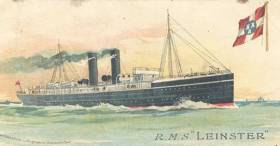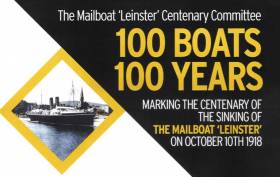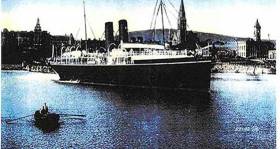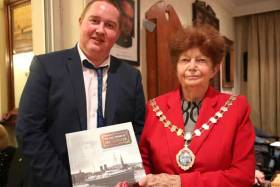Displaying items by tag: RMS Leinster
RMS Leinster - Centenary Calendar of Events In October
#RMSLeinster - Centenary events to mark the tragic sinking of RMS Leinster in the Irish Sea during WW1, continue into next month in Dun Laoghaire, notably on 10 October, the day the 'mail-boat' 100 years ago was struck by a German U-Boat torpedo leading to a major loss of life.
On that infamous date in 1918 of Irish maritime history – the RMS Leinster operated by the City of Dublin Steam Packet had set off from Kingstown (Dun Laoghaire) bound for Holyhead, Wales. On board there were 77 crew among them postal-workers and 694 passengers.
The tragedy which struck the 'mail-boat' took place to the east of the Kish Bank lightship when submarine UB-123 torpedoed the ship, leading to the loss of more than 500 lives. To this day the incident remains as the single greatest loss of life in the Irish Sea.
RMS Leinster was one of a quartet named after the provinces of Ireland and the steam packet company was contracted the Royal Mail Service, hence the 'RMS' prefix designated to the ship's name. At the time of the disaster, the twin-propelled ship was camouflaged through paint effects and armed with one 12 pounder and two signal guns.
RMS Leinster Centenary Events
Events to commermorate the RMS Leinster will be held throughout Dun Laoghaire-Rathdown and is organised by the The Mail Boat Leinster Centenary Committee. To consult the centenary events click here from the 'yellow' brochure. For further news updates, click this link.
Among the various event venues, they include the National Maritime Mussuem of Ireland which is hosting a RMS Leinster exhibition. The museum has a detailed listing of events and activities including links providing further detailed information.
Also available is a calendar of events click here for the 'blue' brochure with front cover depicting RMS Leinster.
The museum located next to the dlrLexicon Library (also holding events) aptly overlooks the Carlisle Pier, from where the RMS Leinster departed on its fateful final crossing.
Green Light for Kish Race – DMYC Organisers Report 'Favourable' Weather Conditions for Sunday Start
Holding their nerve in the face of forecast stormy conditions for the weekend, the DMYC in Dun Laoghaire now report the weather conditions now look very favourable (if a bit wet) for the last major event on Dublin Bay this summer, this Sunday’s DMYC Kish Race, starting at approximately 10.30 from Dun Laoghaire's West Pier.
Earlier this week it was feared the event would be cancelled due to gales, a decision made all the more difficult as this year's edition also serves to commemorate the loss of the RMS Leinster near the Kish Bank 100 years ago.
Race organiser Neil Colin told Afloat.ie 'We have added a further detail to the event, in that all entries will be given a White Flower (biodegradable) before going afloat, and asked to take a moment as they round the Kish, and drop the flower in the water, as a memorial to the event almost 100 years ago".
It's a touching thought and a symbolic gesture to those who perished.
The entry system is open on www.DMYC.ie
RMS Leinster Commemoration Races on Dublin Bay This Weekend May be Affected by Weather
This year's Centenary of the wartime sinking of the mailboat RMS Leinster on 10th October 1918 will see a significant Dun Laoghaire and national commemoration on the day itself writes W M Nixon. As part of the buildup to those official events on Wednesday 10th October 2018, this weekend the sailing community is giving special Leinster Centenary emphasis to two major annual events on Sunday - the Dun Laoghaire Motor YC's Kish Race, and the Dublin Bay Old Gaffers Association Leinster Plate Race.
Inaugurated in 2013 in memory of the Leinster tragedy, the Leinster Plate was presented by the Post Office Workers Union to the DB Old Gaffers Association to mark the OGA’s Golden Jubilee in that year, and to particularly recall that the numerous death toll on the Leinster included 21 postal workers who had been working in the ship’s sorting room at the time the torpedo struck. Normally the Leinster Plate would be raced for in June. But for 2018, the Race will be held this Sunday, 23rd September, in conjunction with the annual Kish Race organised by the Dun Laoghaire Motor Yacht Club. DMYC expects that there will be approximately 70 boats competing in the Kish Race.
The main Kish Race starts just outside Dun Laoghaire harbour at 1030 on Sunday morning and the DBOGA Leinster Plate Race will start on the same line at 1045. As usual, the DBOGA course will either follow or cross the track of the RMS Leinster on that fateful day in 1918. The Leinster Plate will be presented to the winner during the official commemorations in Dun Laoghaire on October 10th. Starting this year, the winner will also be presented with a replica of the Leinster Plate which he or she will retain for the year.
This Saturday 22nd September, DBOGA (most of whom are based at Poolbeg Y & BC) will organise an afternoon race, starting around 1500 hrs near Poolbeg Lighthouse, to take the fleet to Dun Laoghaire. VHF channel 77 will be used for race information on Saturday afternoon. Boats will moor in Dun Laoghaire Marina on Saturday night, and there will be a social evening hosted by DMYC in their clubhouse.
However, in view of the unsettled period of exceptionally stormy weather being currently experienced, DBOGA have stated that they will be making a definitive confirmation of their weekend’s arrangements on Saturday morning. Meanwhile, Neil Colin of DMYC and organiser of the Kish Race has been closely monitoring the weather and a range of prediction sources and agrees that while some forecasts are not favourable, others are more optimistic for Sunday. He told Afloat.ie this morning:
“We plan to stand over our plans to run the Kish race as scheduled but will review the situation on Saturday. Our contingency plan is simply to postpone the race one week, to Sunday 30th September, and in the event, we have to abandon, all entries will be fully refunded.
While we aim to be responsible organisers, the final responsibility rests with the Skippers to consider the safety of their crew and craft, and to make the decision to sail or not, bearing in mind their own abilities and expectations”.
Centenary Lecture: The Sinking of the Leinster
#Lecture - In this centenary year of the great disaster that struck RMS Leinster, the Dun Laoghaire Borough Historical Society is hosting next week an illustrated lecture titled "The Sinking of the Leinster".
Presenter Cormac Lowth will outline the disaster which occurred in the Irish Sea when the mail-boat RMS Leinster having departed Kingstown (Dun Laoghaire) Harbour bound for Holyhead, was torpedoed off the Kish Bank by a German submarine during WW1 on October 10th 1918. The incident on board the City of Dublin Steam Packet vessel led to a horrendous loss of life.
The evening lecture is on Wednesday, September 19th at 8.00. The venue is the Royal Marine Hotel, Dun Laoghaire, where there will be an admission fee of €3.
At the hotel off Marine Road, free car parking in the grounds of the venue is available to those attending the lecture. Check in your ticket at the reception desk.
For further information on other events this month and in October, organised by the The Mail Boat Leinster Centenery Committee visit their website by clicking here.
100 Boats for 100 Years: Commemorating the Centenary of the Sinking of the RMS Leinster
The Dun Laoghaire Motor Yacht Club has announced the 2018 edition of its Kish Lighthouse Race will be known as “100 Boats for 100 Years”, reflecting the forthcoming commemoration of the centenary of the sinking of the RMS Leinster with the loss of 501 lives on Dublin Bay in 1918. More details on that sinking here.
Together with the Dublin Bay Old Gaffers Association, the sailing event is planned to combine a regular format yacht race to and from the Kish, alongside a rally-style event for the traditional vessels and old gaffers, contributing to an exciting day of boating on the bay for everybody and a fitting commemoration of the tragic loss of so many lives.
DMYC's Neil Colin tells Afloat 'We hope to see the competitive racers, recreational sailors and traditional boaters all involved'.
For more details and entry for the event click here
A pre-centenary gathering of families and relatives of those who were aboard the RMS Leinster when it sunk in 1918, was held in the Royal Marine Hotel, Dún Laoghaire, today.
Hundreds of relatives and friends of the Mail Boat Leinster passengers gathered to hear details of the planned Centenary Events, which are set to take place throughout September and October 2018, across Dún Laoghaire and Dublin City.
The mail boat was torpedoed by a German submarine not long after it had left Kingstown (Dún Laoghaire) harbour on its way to Holyhead. The loss of life totalled 501 and it brought the First World War, in its final stages, very close to Irish shores.
Highlights of the centenary events will include;
An Post is set to stage a significant display in Dún Laoghaire Post Office and is set to issue a special edition stamp to mark the centenary in October.
22nd & 23rd September 2018 – 100 Boats for 100 Years A maritime tribute – from Dun Laoghaire Harbour to the site of the Leinster wreck and back.
6th October – DLR Family Day at the LexIcon
Incorporating exhibitions of St. John Ambulance rescue equipment used 100 years ago and actors in period costume.
7th October – Deansgrange Cemetery
Tour of Leinster associated graves, conducted by John McCann of DLR County Council, followed by official unveiling of a monument to Leinster hero William Maher.
10th October – Centenary Day
7a.m. Special wreath laying ceremony at the site of the Leinster wreck (tickets sold out)
9a.m. Main inclusive Leinster Centenary Commemoration – details to be announced – all welcome21st October – The Pro-Cathedral Special mass to be celebrated by Diarmuid Martin, Archbishop of Dublin, in memory of all victims of the Leinster disaster.
The National Maritime Museum, Moran Park, Dún Laoghaire, will hold several events throughout October to coincide with the commemorations.
The Mail Boat Leinster Centenary is being proudly supported by The Association for Gaff Rig Sailing, Celtic Invoice Discounting DAC, Premier Business Consultancy, Costello Jewellers, DLR County Council, Costello Flowers, The National Yacht Club, Mitchell & Son, The Royal Marine Hotel, Dún Laoghaire Motor Yacht Club and Royal Mail.
RMS Leinster Centenary Book Launched in Dun Laoghaire by Holyhead Mayor & Dún Laoghaire-Rathdown Cathaoirleach
Relatives of victims and survivors of the Dun Laoghaire - Holyhead mail boat Leinster were joined on Thursday night by the Mayor of Holyhead Cllr Ann Kennedy, Cathaoirleach of Dún Laoghaire-Rathdown Tom Murphy, and representatives of the Australian and Canadian Government to launch ‘The Last Voyage of the Leinster’. The book is a very human account of the loss of the Leinster and those who sailed on her when she was torpedoed in 1918 just outside Dublin Bay.
More Irish lives were lost when the Dún Laoghaire to Holyhead Mail Boat sunk in 1918 than on the Titanic in 1912 or the Lusitania in 1915. Most of the 540 plus lives lost on the Leinster were Irish while on the Titanic the number of Irish deaths totaled 78 and on the Lusitania 140.
This book ‘The Last Voyage of the Leinster’ captures the human aspects of the loss of the Leinster to so many families not only Irish but also Welsh, English, Scottish, Canadian, Australian, New Zealanders and American who were unlucky to have been traveling on that day, almost a century ago. The Leinster, which was armed and also carrying soldiers returning to the war, was sunk in a wartime act, just a month before the end of World war 1, by the German U Boat 123.
The book brings together the British and German Ambassadors to Ireland who provided messages of peace and goodwill to the descendants of all those who were on the ship when it sunk and also direct their words to the families of those who were bereaved a few days later when the U Boat 123 hit a mine and sunk with the loss of all aboard.
There is a major emphasis in this book on the postal sorters aboard who were the first to die when the first torpedo to strike the ship hit the postal sorting office with the death of all but one of the postmen present. The crew and ordinary passengers, including many nurses returning to training courses and work in British hospitals, are given great appreciations written mainly by descendants.
As the book states “Family stories handed down through generations is arguably a better means of establishing the truth, especially as families have no agenda other than remembering their dead”.
The contrasting backgrounds of people aboard the ship are explored in great detail. The lives of British Army Officer, Captain Robert Lee, son of the Department Stores businessman and Unionist Edward Lee who died on the ship contrasts with that of another victim, Joseph Blake, one of the postal sorters.
Blake had three sons and five daughters. One son had previously died of his wounds having played an active part in the 1916 Rising, another son went on to be an IRA leader and his five daughters were in Cumann na mBán. Josephs descendants include Liam Whelan, one of the “Busby babes” and died in the Manchester United aircraft crash in 1958, while another is Aidan Gillen, the actor, best known for portraying Petyr “Littlefinger” Baelish in HBO series Game of Thrones. These parts of the Mail Boat Leinster story have never been previously published.
“The Last Voyage of the Leinster” hardback Coffee Table Book retails at €15
Take a Stroll with a Dún Laoghaire Seafront Memorial Tour
#SEAFRONT TOURS – Take in the sea-air while getting to know some historical landmarks, along Dun Laoghaire Harbour's waterfront with the Seafront Memorials Tour. The free guided tour runs every Saturday morning until the 1 September.
The tours take in all the coastal memorials to include the Queen Victoria Fountain, George IV Memorial, the mailboat R.M.S. Leinster's anchor, the Crimean War Cannon and the 1895 Lifeboat Disaster.
The tours start at 11.30 am (1 tour on each Saturday) and they take approximately 1 hour. The maximum number of people for each tour is 20 persons, noting the outdoor event is also wheelchair accessible. No pre-booking is required and places are limited so it is advisable to turn up early.
The tours are part of the 'Summer of Heritage' programme which is now in its fifth year organised by Dun Laoghaire-Rathdown County Council. For information call: (01) 254 2387 or visit: www.dlrevents.ie/heritage.html
Take a stroll along Dún Laoghaire with the Seafront Memorials Tour
#SEAFRONT TOURS – Now that the bad weather that covered half of the country is behind us, the forecast at least for Dublin and next Saturday is more promising. So why not consider taking a stroll with the sea-air along the waterfront in Dun Laoghaire Harbour and learn some local history by taking a Seafront Memorials Tour. The free guided tour runs every Saturday morning until the 1 September.
The tours take in all the coastal memorials along the harbour's waterfront including the Queen Victoria Fountain, George IV Memorial, the mailboat R.M.S. Leinster's anchor, the Crimean War Cannon and the 1895 Lifeboat Disaster.
The tours start at 11.30 am (1 tour on each Saturday) and they take approximately 1 hour. The maximum number of people for each tour is 20 persons, noting the outdoor event is also wheelchair accessible. No pre-booking is required and places are limited so it is advisable to turn up early.
The tours are part of the 'Summer of Heritage' programme which is now in its fifth year organised by Dun Laoghaire-Rathdown County Council. For information call: (01) 254 2387 or visit: www.dlrevents.ie/heritage.html
Dún Laoghaire Seafront Memorials Tour
#SEAFRONT TOURS – With glorious weather hopefully holding, seize the opportunity by taking the sea-air and learn at the same time. Sounds like a good combination, so why not consider joining the Seafront Memorials Tour which is a guided tour in Dun Laoghaire Harbour running every Saturday morning until the 1 September.
The tours take in all the coastal memorials along the harbour's waterfront including the Queen Victoria Fountain, George IV Memorial, the mailboat R.M.S. Leinster's anchor, the Crimean War Cannon and the 1895 Lifeboat Disaster.
The tours start at 11.30 am (1 tour on each Saturday) and they take approximately 1 hour. The maximum number of people for each tour is 20 persons, noting the outdoor event is also wheelchair accessible. No pre-booking is required and places are limited so it is advisable to turn up early.
The tours are part of the 'Summer of Heritage' programme which is now in its fifth year organised by Dun Laoghaire-Rathdown County Council. For information call: (01) 254 2387 or visit: www.dlrevents.ie/heritage.html






































































